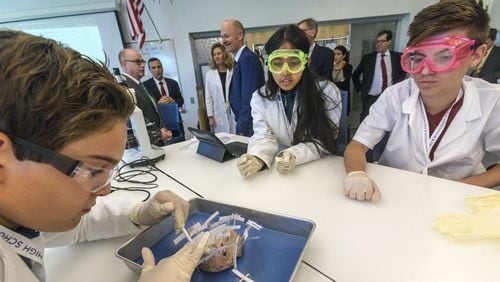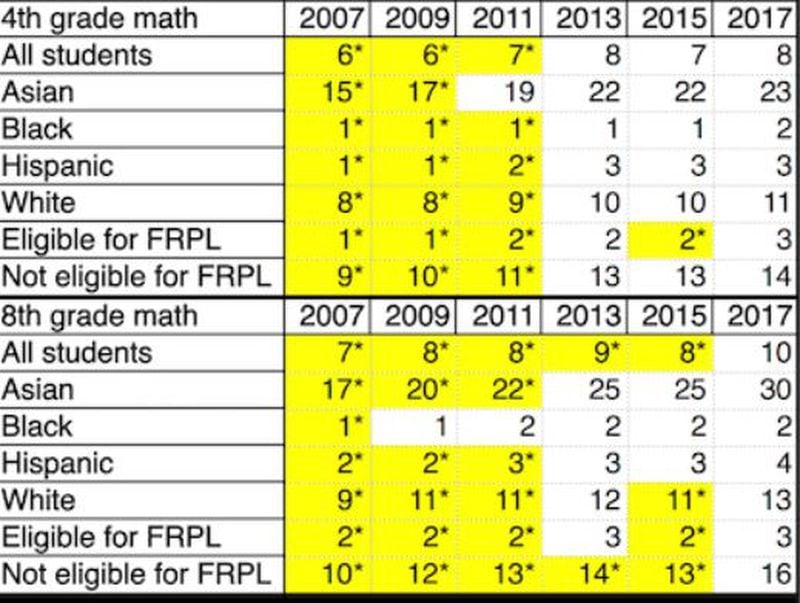The 2017 results on the National Assessment of Educational Progress released Tuesday showed little real progress in math and reading performance by the nation’s 4th and 8th graders.
Except for one group. High achievers.
Why?
That question is already being pondered by education advocates. Deep dives into the data from the national test, which this year offers a window into how students approached problems, will likely provide some clearer answers.
Writing for the Thomas B. Fordham Institute, Brandon L. Wright noted more students reached that most rarified of NAEP levels – advanced -- in 2017 than in 2007 in both grades, both subjects, and every subgroup.
That stands in contrast with the overall math and reading performance, which essentially stagnated despite concerted efforts in the last decade to focus on math and reading skills. While those skills are accelerating among high achieving students, they are flattening or declining among the most at-risk.
First, some clarity. NAEP -- which tests a randomly-selected group of fourth- and eighth-grade students in math and reading every two years -- classifies student performance as basic, proficient and advanced. But proficiency as defined by NAEP does not mean grade level as parents might assume; it means competency over challenging subject matter, which typically exceeds grade level.
(You can find Georgia's results here.)
So, it's not surprising many American students, both in public and private schools, fall short of the NAEP proficient level. In fact, a 2007 analysis found 27 percent of eighth graders in Singapore, the top scoring math nation in the world, would not reach proficient on the NAEP scale.
So, the advanced level on NAEP represents elite achievers. But there are wide disparities in which student groups reached that level as this chart shows:
As Wright explains:
And in every instance, the difference across that decade is statistically significant—sometimes massively so. In eighth grade math, for example, almost one third of Asian students reached the test's top level in 2017, a 13-percentage-point increase over ten years. This is all rather remarkable. And every parent, teacher, and advocate who helped make this universal progress possible deserves a round of applause.
But once the plaudits subside, much work remains to address the data's other takeaway: huge and widening gaps among subgroups of high achievers, discrepancies that Johns Hopkins professor Jonathan Plucker rightly calls "excellence gaps." Yes, black, Hispanic, and low-income students have seen gains, but from a depressingly low base, especially compared to white, Asian, and affluent peers. The 2017 percentage-point difference between white and black students who reach NAEP Advanced, for instance, ranges from 5 points in eighth grade reading to 11 points in eighth grade math. For Asian and black pupils in 2017, it's between 10 and 28 percentage points. All of these are wider gaps than in 2007. And the refrain is the same for low- and high-income students, between which the Advanced-level gap has also widened in both subjects and grades in the last decade.
One theory for the flat scores this year: NAEP’s switch to online testing handicapped low achieving students from less affluent families without technology in the home. Officials with NAEP spent a lot of time Tuesday disputing the new online framework depressed scores. (There is research showing drops in student performance when tests go digital.)
But there are concerns. Kentucky Education Commissioner Stephen Pruitt released a statement saying: "Our students, and those in a handful of other states that still give paper and pencil state tests, seemed to be at a disadvantage with the new online NAEP assessments. It is an entirely different experience taking a test on a tablet than with the paper and pencil our kids are used to. Going digital seemed to have an impact on results, especially in reading." (Pruitt is a former Georgia DOE leader who once taught chemistry in Fayetteville and Tyrone.)
In parsing the overall disappointing NAEP results, many are pointing to the funding woes that still plague many states post-recession.
“It’s very disappointing that gaps between high and low scorers are trending in the wrong direction,” said Randi Weingarten, president of the American Federation of Teachers. “In the 1970s and ’80s, following school desegregation and War on Poverty-era investments, long-term NAEP trends indicated increases in scores for African-American and Latino kids, narrowing the gap between white students and students of color. In the last decade or so, the gains for students of color have leveled off, then stagnated: From 2003 to 2017, average reading and math scores in large-city schools have either stayed the same or dropped. We lived through the NCLB era of test and punish, and we know that states are spending less overall on public education. So, of course, we see gaps related to poverty, race, ethnicity, and where kids go to school. Without resources to manage class size, improve classroom experiences, implement meaningful curricula, and enhance teachers’ skills and tools, we can’t expect the numbers to be the ones we want to see for our children.”
Former U.S. Education Secretary John King, now president and CEO of the Education Trust, said: “Achievement gaps are without question a result of opportunity gaps — deeply troubling inequities that mean in many places throughout the country students who need the most from our education system continue to get less. Students who need the most get less access to equitable resources, less access to effective and diverse teachers, less access to a well-rounded curriculum, less access to school counselors, and less access to essential supports outside and inside the classroom.”
Others cited what they consider a retreat from the tougher school accountability requirements in No Child Left Behind.
Collaborative for Student Success Executive Director Jim Cowen wrote, “We must encourage states to implement strong systems of accountability, while also identifying the schools and districts showing progress in serving traditionally disadvantaged populations. Similarly, teachers will benefit from support in helping students master the skills and knowledge included in higher standards.”
But, if underfunded budgets or weakened accountability undermined the 2017 student performance on NAEP, why were high achievers spared the repercussions? Parents of gifted children maintain their kids were also shortchanged when schools pared back programs and reduced resources.
Any theories?








